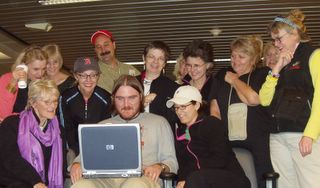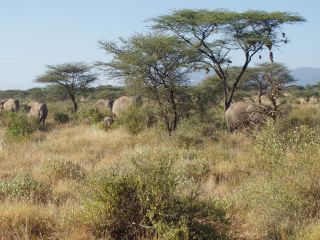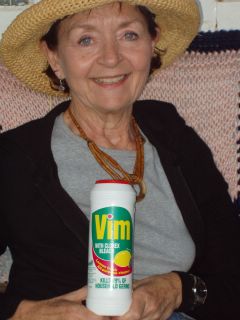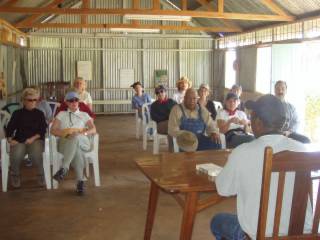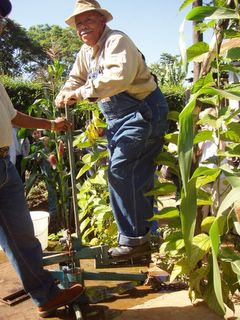Sunday, January 23, 2005
COMMENTS AND PRAYERS FROM FRIENDS AND SUPPORTERS
Saturday, January 22, 2005
Friday, January 21, 2005
LUNCH AT KAREN BLIXEN COFFEE GARDEN AND RESTAURANT

Lunch on the verranda
A cottage on Karen Blixen's farm, the colonial bungalow used by her brother, Thomas Dinesen, when he lived in Kenya from 1921-1923, has become the centerpiece of a new eating establishment. The cottage, which is east of the Karen Blixen Museum--Karen Blixen's home in Africa--in the Nairobi suburb of Karen, was made part of a tea garden in the 1990s. The property has recently become a restaurant featuring an architectural restoration of Thomas Dinesen's bungalow.
Source: http://www.karenblixen.com/coffeegarden.html
TOUR HOME OF KAREN BLIXEN (aka ISAK DINESEN) ~ ("I had a farm in Africa, at the foot of the Ngong Hills…"

West of the city, the suburb of Karen is named after Karen Blixen, author of 'Out of Africa'. Much of the suburb stands on her old farm.
We toured her house which is now the Karen Blixen Museum.
If you click here, you can see pictures from each room (take a virtual tour of the museum).
Here are two other good links -- a writeup about the house and at this site you can even watch videos! (http://www.africanmeccasafaris.com/kenya/nairobi/excursions/karenblixen.asp ).
FRI, JAN 21 - SHOPPING AT UTAMANDUNI CRAFT CENTRE
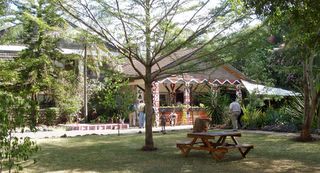
UTAMANDUNI CRAFT CENTRE
Following breakfast at the hotel, Daniel and his drivers took us first to the Utamanduni Craft Center. This was a wonderful place to shop. Even though we did get lower prices for some of the same or similar items later in the day at the Village Market, there was a huge range of items to condiser here and there is something to be said for shopping where prices are set and reasonable! Suffice it to say, we dropped a bundle and all went away thrilled. Downside: I never did make it to the Cultural Village (see their website above) which says of the village:
Utamaduni's cultural village consists of four traditional homes, built according to the customs of the Masai, Kikuyu, Luo and Miji Kenda tribes. Members of the Mzizi Cultural Centre will be happy to show you around these homes and to explain their construction and traditions. Dancers from the Mzizi Centre regularly entertain Utamaduni's clients with vibrant and colourful displays of traditional African dancing.
Thursday, January 20, 2005
DINNER AT THE CARNIVORE RESTAURANT
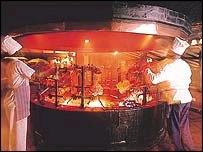
This place was a huge hit for all but the 3-4 committed vegetarians in the crew. (TIP: Don't order the vegetarian pizza. What WAS that?) There is also a shop that sells T-shirts, aprons, etc just at the entrance and several nice shops around the side of the restaurant. The only down side for me was that I was too exhausted to eat. You don't want to make sudden moves at this place as a waiter may be coming o ver your shoulder with a hue sword holding a leg of . . . whagt? giraffe? lamb?
Here is a write-up about the restaurant I found on the web:
What are you having for dinner tonight? Perhaps you fancy a nice piece of crocodile barbecued in spicy sauce, or maybe zebra and salad, warthog and chips, or even grilled giraffe.
They're all on the menu at the Carnivore restaurant in Nairobi, Kenya, which has just been selected as one of the fifty best places to eat in the world by London-based Restaurant Magazine.
A rare honour indeed, especially as it's the only establishment in
Africa to have made the list which was drawn up by a panel of international reviewers, restaurateurs and raconteurs.
In the restaurant whole joints of meat are roasted on traditional Maasai swords over a huge charcoal pit that dominates the entrance of the restaurant.
Carnivore's head chef Joseph Gacheru said he thinks this unique layout caught the judges attention. "Carnivore is totally different because the kitchen... is right at the entrance of the restaurant," he said. "When the guests are coming in that is the first impression they see... the kitchen and the meat being roasted there."
Mr Gacheru said the restaurant only buys meat from suppliers licensed
to cull wild game by Kenya Wildlife Services.
While The Carnivore restaurant is popular with locals as well as
tourists, Mr Gacheru said there has been a slump in the number of tourists dining in the restaurant since the war in Iraq began, but local demand has stayed strong.
THURSDAY, JAN 20 - DRIVE TO NAIROBI THRU EQUATOR
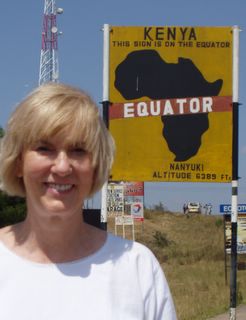
BETH AT EQUATER
Early afternoon, we loaded luggage on the 3 vans and headed back out those awful "roads." We stopped at the equator for "a rest stop," photos and a little shopping, then pressed on. Arriving in Nairobi at dinner time, we checked into the Methodist Guest House. After dragging our luggage to our rooms, we went to The Carnivore for dinner.
Wednesday, January 19, 2005
LION

On our afternoon safari ride, we saw a lion and 2 lionesses - from about 20 feet away!
There were about 10 vans in a group and we just stayed and looked and looked and looked until the lion finally had had enough and got up and wandered off and his wives had to abandon their nice shady spots to follow behind him.
WENDY ELLSWORTH - BEAD ARTIST

Wendy with Alfred at Samburu village
We met Wendy Ellsworth (click here for her biography) (and here for her resume), an American women staying at the lodge, who is a professional bead artist. Last year, she received a grant from (I think) the Pennsylvania Arts Commission and used the funds to travel to Kenya to study the beadwork of the Maasai and Samburu tribes. She was so impressed that she funded her own return trip here this year.
She told us that historically the Samburu used dyed seeds to make their regalia (face, collars, bracelets, anklets, etc.) but then (I think about 50 years ago) they switched to using glass beads. They have used exclusively beads from Czechoslovakia which are rough and have very small holes.
This trip, Wendy brought beads made in Japan that are in new colors and are laser made. They are a higher quality bead and have much larger holes. The Samburu have used exclusively wire and she is teaching them to use needle and thread, too.
She has been working with the women of this village 4 days - teaching them new beading techniques and new designs. She tells us they are thrilled.
When Wendy was here last year, she hooked they up with Beadsforeducation.org and with a friend of hers who markets beadwork and they have generated $30,000 in sales in the USA. Sales of the Samburu beadwork puts girls in school in Kenya.
Wendy has them making chokers and earrings -- both new products for them. You can look at Wendy’s work at her website. It is pretty awsome!
She is also working with the Africa Wildlife Foundation. Wendy is especially pleased that she has found enough friends to sponsor 140 Samburu girls so they can attend school which costs $360 a year for one child (see beads for Education on how you can support a girl).
SAMBURU HUT
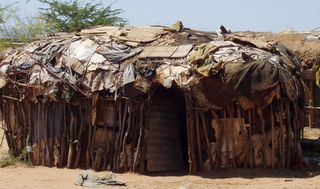
At 8 am and 8 pm, the men convene a parliament to discuss issues; women are not allowed within earshot. (DO NOT get any ideas, gentlemen!). It is also at these parliaments that issues such as marriage and circumcision get decided.
The married women have a large hole in one earlobe and wear a beaded hoop in that ear. A string of beads that is worn around the neck is threaded through that hoop.
INSIDE SAMBURU HUT - COOKING AREA

Margaret is teaching a pre-school at the village. She told us that they use a witch doctor rather than a physician, surround their village with thorny shrubs to protect them from animals and other tribes men who steal their cattle and kill their tribesmen (mostly from Sudan and Ethiopia - both of which are nearby). They buy maize from members of another tribe but feel they are overcharged.
Rich men have 8 wives (one for each cow) and each wife (and her children) live in a separate hut. Poor men have only 2 or 3 wives.Wives have about 15 children but many die. If a woman’s husband dies, she ca not remarry. If her husband’s family is kind, she can continue to live with them; otherwise she must return to her own family.
There were only 2 or 3 young men present -- the men “had gone to visit with men in neighboring villages”. The boys were with the herds of cattle and goats and camels grazing in the area. No one owns land, they just move about to where the good grass is at the time.
SAMBURU WOMEN
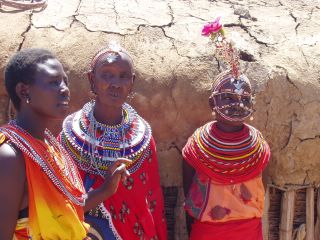
MARGARET (LEFT) WITH MARRIED, UNMARRIED SAMBURU WOMEN
When we reached the village, a young women who spoke excellent English named Margaret met us and was our “guide.” They collected their fee and then the women of the village (about 12) sang and danced to welcome us. Then we watched a blacksmith make knives, walked through a typical hut (pretty bleak), heard about their customs (they are nomadic herders who consume mainly blood, milk and meat, they practice polygamy and male and female circumcision, etc.).
DANCING WITH SAMBURU WOMEN

A Samburu settlement is known as a nkang or manyatta. It will normally consist of six or more huts built in a rough circle with an open space in the centre. The circle of huts is surrounded by thorn bush fence.
Source: http://en.wikipedia.org/wiki/Samburu
VISIT TO SAMBURU VILLAGE
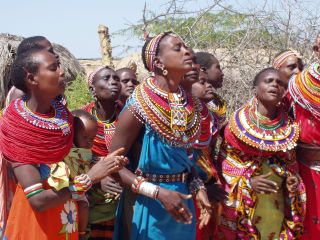
We returned from the morning game drive about 10 am. After we had breakfast at the lodge, we reboarded our vans for a trip to a nearby Samburu village.
The Samburu are like the Maasai in that they strive to maintain their culture and heritage. They intermarry with Maasai tribe members although it seems the Samburu hold to traditional ways even more that the Maasai (see links to writeups below).
You may not take their picture nor can you photograph their belongings such as their herds of cattle, goats, camels, etc. Instead, we paid about $10 per person to visit a select site and there we could ask questions, take photos, and purchase their wares.
This picture of the women in the village greeting us upon arrival.
This link takes you to an excellent writeup about the Samburus of Kenya.
So does this one.
WED, JAN 19 - 6 AM SAFARI RIDE

We went out at 6 am in twilight. We saw many of the same kinds of animals as yesterday but today we saw them in herds. We saw 3 or 4 zebra grazing, 5 grand gazelles, 8 giraffes, a water buffalo, a herd of 20+ impala, baboons, tiny antelope the size of jack rabbits (sounds like dick-dicks), and lots of birds including the secretary bird, a saddlebilled stork, and a hook beaked bird. Oh, and monkeys. Someone in the group, I think Jennifer Price, is keeping a list of the birds we have seen for Ron Rosser.
Tuesday, January 18, 2005
HEADING OUT ON AFTERNOON (3:30-7) SAFARI

We went out on a game drive at 3:30 and got back after 7 pm.
We saw elephants impala, water buffalo, guinea, giraffes, oryx, ostriches, tons of birds.
Dinner was a buffet on the lawn with BBQ and Samburu dancers (like Maisai - and, Daniel told us, they WILL stone your van if you take their picture without permisison.
Looks like Sea Island in Georgia.
MONKEYS AT THE LODGE
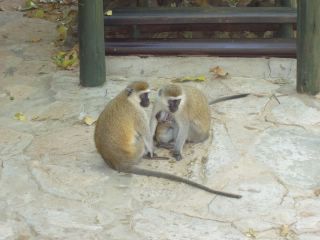
We are located within the Shaba Game Reserve.
The hotel describes itself quite rightly as “an oasis in the heart of Eastern Kenya. A unique African experience for those of you with a true sense of adventure.”
This game reserve was made famous by the late Joy Adamson (she was murdered by poachers) and her lioness, Elsa. The area is sometimes referred to as “Born Free country.”
The lodge sits on the banks of the Uaso Nyiro river which, we are assured, is full of crocodiles (the “feeding” can be observed at 7 pm each day).
There are also lots of little monkeys around; one of them manages to swipe a roll of f the buffet table at every meal! There are 80 chalet style rooms and a few fancier suites. The area supports giraffe, Grevy’s Zebra, Gerenuk and Beisa Oryx, elephant, and 150 recorded species of birds. There is a beautiful swimming pool and trickling (man-made) streams throughout the resort grounds.
We wish you were here to enjoy it with us!
TUES, JAN 18 - DRIVE TO LODGE

We left the bio-intensive agricultural center about 9:15 am in Daniel's three vans and had paved road for the first hour.
Then we hit the worst roads yet - truly awful. We laughed that it was like being in those electric massage chairs.
The lodge is beautiful and modern. The rooms are large and beautifully decorated and clean. The restaurant is like the tiki house at Disney World (so I am told) and the food is buffet style and delicious.
We are back amongst the living.
Monday, January 17, 2005
NOTE FROM SHIRLEY, FINAL THOUGHT FROM JEAN
NOTE FROM SHIRLEY
Shirley wants her family to know that, at the Mubichi party last night, she ate goat and danced native dances with the women (be sure to tell mother).
ALL of the women danced in a circle while the African women sang songs.
Periodically, they would stop and explain to us the lyrics.
We especially liked the onE about women being the salt of the Earth!
That is certainly the case with these extraordinary women in Meru.
Shirley
A FINAL THOUGHT FROM JEAN
It is midnight and, like everyone else on this trip, I am dead tired. But I wanted to add a final thoughts before signing off. I am normally not very good at expressing my feelings about faith and religion and tonight I am further handicapped by extreme fatigue. But here goes.
First, we want everyone to know how very much we appreciate your prayers for our wellbeing while we are in Africa. Even from afar, we can feel your love and concern and well wishes.
Second, we want to thank each person who contributed in one way or another to this mission trip. We have brought a bag of "goodies" to every agency or facility we have visited -- thanks to your generosity. Thanks especially to Jeff; your gifts are now scattered across Maua and Meru and are in the hands of very deserving people. Bless you.
Finally, we want you to know that we feel very bless to have been able to make this journey. We have encountered a Christianity here in Kenya that is refreshing and invigorating and rejuvenating. People introduce themselves by saying, "My name is Betty Mwangi and I am born again through Jesus Christ my Savior." We pray before and after every meeting and meal and often end a gathering by reciting in unison a benediction. No Methodists here smoke or drink alcohol. I have not heard a sarcastic remark or unkind comment in all the time I have been in Kenya. There is a wholesomeness that is worthy of emulation. Conversation with Kenyans begins with sincere inquiries about yourself and your family. Only after they have taken a little time to get to know you and to assess how you are REALLY doing do we get down to the business at hand. The members of this VIM trip talked a lot this evening at dinner about the many ways we have been touched and changed by the wonderful people we have met here in Kenya. All agreed this has been a God directed mission and that we Americans have been the primary beneficiaries.
Jean
JOHN AND JANET MWALIMU - BIO-INTENSIVE FARM, MERU

Gardens at the farm
Tonight, everyone (except Alfred and Jean) ate dinner at the bio-intensive farm and is sleeping in the farm's dormitories. Marshall rewired one of the showerheads (which contains a heating unit) so there are now two functioning showers at the farm! Yeah.
Jean and Alfred spent their final night in Meru at the home of Steven and Florence Mubichi. We stayed up very late talking about all the deserving projects we visited (we are suffering from a mild case of "donor fatigue") in an effort to prioritize and focus. We also exchanged gifts and I am still wearing my wonderful Kenyan necklace and earrings as I type this at midnight!
Everyone has asked me to post the contact information for the director of the farm and his wife, Janet, who was matron of Maua Hospital for 21 years and just retired (Stanley Gitari's wife, Mary took over the position after Janet retired). They have been simply wonderful. So here it is:
John and Janet Mwalimu
PO Box 443
Meru 60200
Kenya, Africa
Email: Mwalimu@salpha.net
REBA THE GOAT

As we arrived back at the farm, John pulling in with a goat he had just purchased with the cash gift we had presented earlier. We wanted to name this lovely, noisy, female goat soomething to remind John of Oklahoma. After considerable discussion, she was named in honor of Oklahoma country and western signer Reba McIntyre. Jennifer P looks on approvingly.
Re-e-e-e-e-e-e-e-e-e-b-a-a-a-a-a-a!
WOMEN'S WEAVING PROJECT, MERU, KENYA

Daniel and his drivers (who transported us from Nairobi to Maua) drove today to Meru and will be at the Bio-Intensive Farm at 8:30 AM tomorrow to drive us to Samburu National Park for our safari experience.
We have left a lot of our clothing behind with Florence; she will take it to Maua Methodist Hospital tomorrow for the Palliative Care Program.
We don't know if we will have access to the Internet again during our travels. So, if you don't hear from us during the next three days, know that we are all healthy and feeling great and having a wonderful time.
We marvel at the degree to which everyone has gotten along (even though many of us did not know each other before now). We have loved having young people (Jennifer, Marshall and Summer) with us.
We send you our love and pray that God will bless you and keep you safe and well until we see you again.
MONDAY AFTERNOON
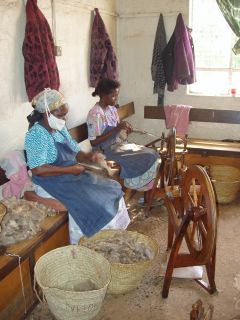
Carding wool at Makena Textile Workshop (Womens Project).
We ate lunch at the farm. Then some rested and repacked. Others went with Kathy to pay a courtesy call on the Mayor of Meru. They ended up chatting with the city manager who identified his greatest need to be a firetruck (they have a fire station but they don't have a truck.) Meru has a daytime population of 130,000 and a night time population of 70,000. The annual budget of the city is 50,000 Kenyan shillings.
NOTE: Our Vice Mayor (Kathy) said next time she would bring a small flag and/or a plaque and buisness cards of key administrators in her city so Meru officials could exchange emails.
A third group tooke a brief tour of the Kaage School for the Mentally Handicapped where they presented a gift bag.
In the late afternoon, we climbed into the vans once more for a visit to the Makena Textile Industry (Women's Weaving Project). We saw women carding wool, spinning wool, weaving wool (above picture), and even saw where they do the tye dye process. The had a small shop and most of us purchased an item or two - hot pads, purses and bags, stoles, blouses, shirts and dresses and even woven carpets.
KENYA METHODIST UNIVERSITY, MERU, KENYA
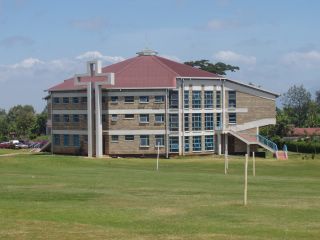
Following tea at the School for the Deaf, we drove to Kenya Methodist University where we met with the Vice Chancellor (a former cardiologist) and then had a walking tour of the campus. He noted that this school is a Christian college located in a rural area of Kenya. They school considers community service and employing women to be very important (to "empower homes").
This is a very young college but is growing fast. They have over 1200 students enrolled but only have housing for about 200.
They have a beautiful new administration building, a fine library building that needs more books and a large chapel (can seat up to 1700 in a pinch).
The last building we visited housed the women's project which was started in the 1980's (before it was a college). The one story, two room building housed a kitchen and a "restaurant" that had just opened today! The curriculum is what we might call "culinary arts and restaurant administration."
Interesting note: The campus is lined with electric fencing along one side to keep the elephants off the campus grounds. We didn't see any but the campus abuts the route elephants take when moving between the grasslands and the forests of Mt Kenya.
MON, JAN 17 - TOUR SCHOOL FOR THE DEAF
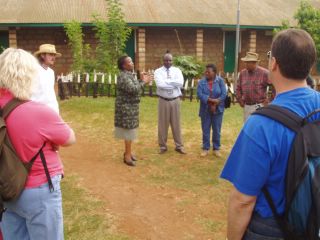
After regrouping at the farm, we walked over to the School for the Deaf for a tour of this program. They use American (rather than Kenyan) sign language here because so many of their staff have been trained in the United States. We met Rhonda, the head teacher and Alfred, the deputy superintendent who greeted us. Florence Mubichi is the one on the right in the picture. Students range from nursery to 22 year olds. They use the normal educational system. There are 3 high schools for the deaf in kenya; if a student doesn't make it into one of them, he or she may stay here and take vocational-technical classes.
The school was founded in 1965 by the Kenya Methodist Church. It started with 7 children and now has over 600 graduates and 165 currently enrolled. (The school was built for 120, so there is some congestion.)
Like most schools in Kenya, this is a boarding school. There is a stigma about having a deaf child in Kenya. Many cases of deafness can be attributed to malnutrician during pregnancy. Many students come from outside this part of Kenya. They go home to their families during the usual school breaks -- April, August and December.
The school dreams of having a library for deaf students, deaf adults and professionals working with the deaf. It would also be open to others in the area as well.
Sunday, January 16, 2005
KAAGA CHILDREN'S HOME

Kaaga Children's Home (Street Children Project)
Sunday afternoon we toured this facility for very poor area children from 4 to 22 years of age. The children sang for us and we met the staff. Then students took us for a tour of their dormitory, the farm, other buildings.
This program started as a feeding program for the street children in Meru and grew until it was selected by the Kaaga Methodist Church.
According to ints director, the program has four dimensions: Spiritual (knowing God), Mental (intellectual growth), Physical (learning about personal hygiene, getting exercise, etc), and Social (learning to interact with others).
In addition, these children learn to manage cattle (there is a small "farm" on the property).
The program also feeds the homeless children in the community.
Many of the children served are orphans who had been living on the streets. Besides providing this "home," the church helps with the cost of their schooling.
SUNDAY, JAN 16 - COMBINED CHURCH SERVICE

Rebecca delivers gifts during church service
What a wonderful day we had today. Following breakfast, our host families brought us to the Kaaga Church for a combined worship service. I am sad to tell you that there were so many people at the church today that many had to sit outside.
The tem members arrived early and got settled in the front pews. The church is quite lovely though a bit rustic as the congregation has left it exactly as it was when it was constructed in the 1940s. (They did add a cover at the back and a small vestry with a restroom.)
There are banners hanging on the walls which read "I am the vine, you are the branches. Abide in Me," "I will search for my sheep and look after them," Jesus - Light of the world," "Let us praise God's glory," and "Jesus, the best gift of all."
Virgie gave the first reading and the English choir sang. Then Barbara gave the second reading and the Ebachanezar choir sang. We observed a moment of silence for the Tsunami victims and two men sang. Then the English youth singers sang, Marshall gave the third reading, there were intercessionary prayers, the Church Chairman spoke, and we presented our gifts to the church (choir robes, Adult Sunday School materials, Children's Sunday School materials, Susan Lucky's final quilt, a contribution to the church of $1,000 and a greeting card signed by members of the Nichols Hills United Methodist Church).
Children from the School for the Deaf (which we tour tomorrow) presented an interpretive dance, children from the Kaaga Children’s Home which we toured this afternoon) danced, the offering was taken and Scott gave a wonderful sermon. And there was some more singing - -
The 3 1/2 hour service flew by and before we knew it we were all out on the lawn visiting and then in the Fellowship Hall enjoying a combination tea and lunch. The weather (as usual) was perfect. We were surrounded by flowers in bloom and brightly dressed members of the congregation. It was simply glorious.
KAAGA METHODIST CHURCH, MERU, KENYA
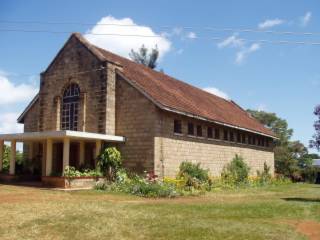
The Kaaga Methodist Church in Meru, Kenya is "the mother church of methodism in Kenya."
The plaque at the entrance of the Fellowship Hall reads, "Kaaga Pathfinder Memorial Hall. Built to the glory of God by both members of Kaaga Church and First United Methodist Church, Bartlesville, Oklahoma in loving memory of all the saints who live and die for the kingdom of God. Officially opened by Rev. Dr Ray Owen, Senior Minister, Bartlesville, Oklahoma, and Presiding Bishop Rev. Lawi Imathiu, Methodist Church in Kenya on July 20, 1986." The church is unchanged except for the covered entrance and rooms built to one side.
FROM REBECCA MORTON
Blessings,
Rebecca
Saturday, January 15, 2005
TEAM MEMBERS STAY WITH LOCAL FAMILIES

Waiting to be picked up
VIM team members were picked up at the Bio-Intensive Agricultural Center by host families. The eighteen members were divided amongst 9 local households -- all members of the Kaaga Church.
We had dinner at our host family's home and visited before retiring for the evening.
I am one of four members staying with Steven and Florence Mubichi. They have a beautiful home and we are very comfortable. After I finished posting to the weblog last night, I enjoyed a leisurely scrub in the tub with hot water and fluffy towels and a comfortable bed! Yeah.
It was fun to compare experiences with our fellow team members when we met back up this morning. Staying with host families is a wonderful way to learn how Kenyans live and think!
The Mubichis have a computer in their home and it is connected to the Internet (a real luxury in Kenya) which is how I am able to get this information posted to the weblog.
So, thank you, Florence and Steven!
WHO STAYED WITH WHOM:
Barbara and Cindy stayed with Mrs. Judith Mbobua
Virgie and Summer stayed with M&M Stanley Mwithimbu
Gay and Shirley stayed with Judy Kaburu
Rebecca and Jennifer M stayed with M&M Erastus
Darlene and Helen stayed with Doris Mwirichia
Alfred stayed with M&M Jonathan Muriungi
Beth stayed with M&M Jane Kirera
Scott, Sandra, Jennifer P and Jean stayed with Steven & Florence Mubichi
MARILYN BRENCHLEY'S KEMU COFFEE FARM
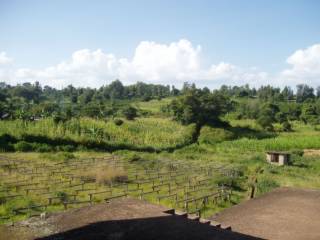
We drove in several cars out into the rural area around Meru where we met up with Marilyn Benchley - an American Methodist elder with the NW USA conference. She is from Richmond, Washington, USA.
Marilyn settled in Meru in 1990. Under her supervision, Kenya Methodist University (KEMU) has just purchased a coffee farm which we toured. She helped form the Kenya Methodist University Development Association which will process and sell the coffee (as well as the vegetables and fruits growing on the land) as a way to raise funds for KEMU.
KEMU previously was a vocational school but became a university 7 years ago. It started with 7 students and today has an enrollment of over 1,000 students.
The farm is 80 acres ands they took possession last September. It was rundown (all bush) and now it is beautiful They managed through donations to purchase a tractor. They have planted 1,400 trees and plan to plant 100 times that before they stop (this area used to be forest and has been cleared in recent years).
It will be a research facility for the undergraduate and graduate agriculture degree programs at KEMU. They have 20,000 coffee trees and we picked coffee beans and learned how coffee is made. There is a farm house that house 8 to 10 and will host VIM teams in future years.
COMPASSION PROGRAM, KAAGA METHODIST CHURCH
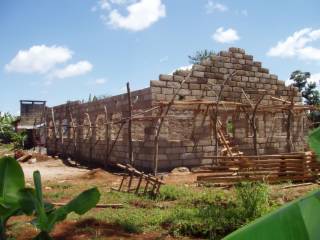
On Saturday, we observed the Compassion Program which started with 110 children in 2000. They now have 403 children enrolled and another 300 graduates of the program.
The classes are held on the grounds of the church. The students wear uniforms (provided by the church) and sit in groups of up to 60. They are grouped by class level, sitting in plastic chairs in semi-circles. On the day we visited, they were perfectly behaved - quiet, attentive, polite. Tailoring classes for the older students were held in the fellowship hall.
This program is partially funded by Compassion International -- an NGA based in Colorado Springs, CO. Compassion International provides funding to cover operating costs but does not provide money to house the program.
The classes we met with were studying personal hygiene, religion, tailoring, embroidery, and more. After lunch, 5 little ones recited a poem about redemption through Jesus Christ, 18 sang a song, and 3 teenagers performed a dance to religious music. We were welcomed by the Chairwoman of the church and we were introduced to the many social workers who serve as instructors for this program.
The church members have begun construction of a permanent facility that would hold classrooms, supply room, administrators' offices and a small kitchen and bathroom (see photo above). This would be a fun VIM project to work on and very gratifying as it touches so many deserving children.
SAT, JAN 15 - TOUR OF BIO-INTENSIVE AGRICULTURE CENTER, MERU, KENYA

Bio-Intensive Agriculture Center, Meru, Kenya
Last night, after viewing the sacred lake, we returned to the farm where janet served us a delicious dinner, we sat on the veranda or out in the garden, admired the amazing stars and - for some of us at least - truly relaxed for the first time since we hit Kenya. This area is so lush and the farm is beautifully kept.
Then we retired for the evening - the 15 women slept in one big open dormitory and the three men slept in the other. John has dreams of installing partitions in the dorms to give a little privacy and inproving the showers (PLEASE!) and the toilet area. Using the bathroom in the night entails a trip (so now we know why they said to bring a flashlight!) down past the cow shed. We are definately not in Kansas, Dorothey!
Our intinerary permitted us to sleep late (8 am versus 5:30 -- THANK YOU, Florence!!!) and Janet had a lovely breakfast waiting for us. Around 9:30 am, John took us for a teaching tour of the farm.
Here is a link to the General Board of Global Ministries description about this program. The Advanced Special I THINKis #014217-2RA.
The farm was established by the first Methodist missionaries who came to Kenya in 1862. The ruler of the country at the time gave them this land. The main building was built in 1919 and used to be a school. It was converted to a farm in 1992. The canopy over the stairs (and across the veranda??) was added in 2003 by a VIM team!
Missionaries started spreading the Gospel and also sartede up girls schools and boys schools and churches (until then, no one here went to school). There is a second house on the property that was built later; a British lady is living there but she was away during our visit.
This 2 acre facility is a totally organic demonstration farm. Students come to the farm to learn and john also goes out into the area to teach. (John feels that improving the dormitories and showers would attract more students to the farm; I have to agree!)
The corn here is 9-12 feet high; in fact, everything is huge and lush and delicious (our lunch came from the gardens)!
John's mission is to teach farmers how to get greater yield from their land. He also provides training on nutrition and HIV/AIDS. Ninety percent of those who come for training are women. The first year he was here, he had 500 come, the next year 780, then 970, 1070 in 2003 and 1,200 were trained in 2004.
He teaches about crop rotation,
Like an American USDA Agricultural Extension agent, he also introduces improved strains of plants to farmers in the region. For instance, he showed us a very fast growing form of South African Eucalyptus tree that goes 24 feet tall in two years when it can be harvested; it doesn't require lots of water, it is self pruning, and it is fast growing. It can be used to make medicine and organic sprays for crops.
We saw a nifty hay stall built by a VIM team from Texas for "zero grazing" (no free range); the cow stalls were spotless with a sleeping area and a separate feeding area. The area is cleaned twice a day and the maure goes into a compost pile (as does everything on the farm. In fact, if you weren't composting before you saw this place, you left a believer! We met the milk cows - Betty, Susan and Carrie. They grow and harbvest napier grass (which they chop up and feed to the livestock).
While I am thinking about it, we would all like to thank the VIM team from Texas who laid the concrete walkways throughout the complex. THANK YOU!
The dorms were built in 1930 when the facility was a girls school. we saw a water pump designed like a "Stairmaster;" Alfred tried it out and it worked well -- you just have to keep up the pace if you want the sprinkling system to water your crops at full force! Go, Alfred, go!
Because of the composting (and double digging to enrich the soil, John practices "intensive farming" ; where normally corn would be planed 2 feet apart, he plants 5 in a 2' by 2' area.
There are stalls for calves and goats and vertical vegetable gardens that Satterleys Nursery in Oklahoma City would be proud of.
We went into a new building built be a Texas VIM team that includes a kitchen, dining area and a conference/classroom. He currently puts 100 people into the calssroom but it is unfinished and gets hot. It needs a ceiling, windows on the back side for cross ventilation, plywood for the walls, etc. And he needs lots more chairs. Infact, he left us with a booklet outlining needs at the farm And, I have to say, a VIM trip to this farm alone would be divine and the work needs to be done and the whole effort is doing a great amount of good for the area. Except maybe that part about starting to do bee-keeping; not sure I'm into bees myself. So - Hurrah for John and Janet and this beautiful place!
By the way, if you want to make a small contribution, send John money for twin bed sized sheets. What WERE those things we slept on, anyway? They felt like polyester bedspread material. Sorry to gripe, john, but the sheets (and the one working shower - but Marshall took care of that) were the only at this lovely facility.
